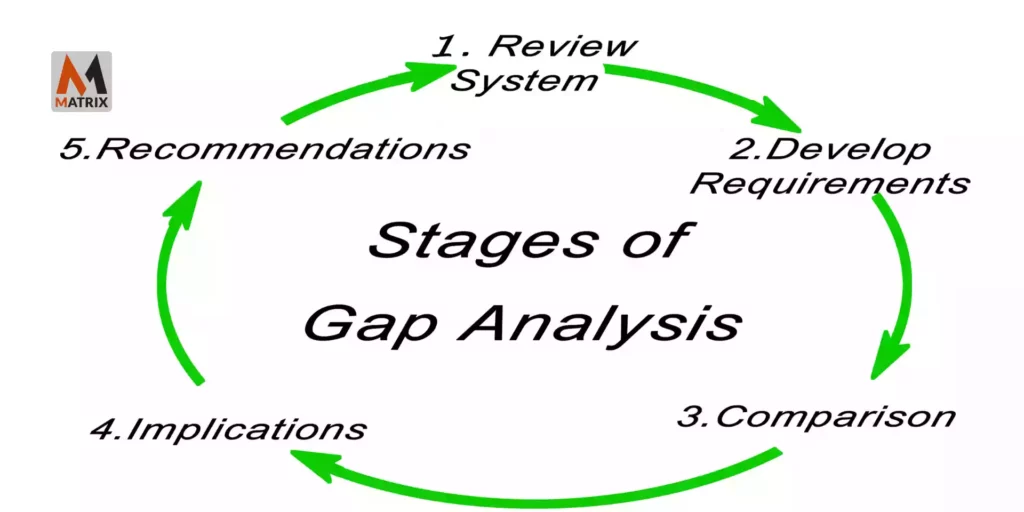How to Performing a Gap Analysis Method and Examples for B2B and B2C Companies
Learn how to perform a gap analysis method and examples for financial and technology industries. I cover gap analysis tools, free gap analysis templates, how to do a gap analysis, and performance gap analysis.
needs analysis, needs assessment, or need-gap analysis needs gap analysis
Performing a gap analysis is an essential part of improving your business operations. You can focus on fixing these deficiencies and boosting your performance by identifying the areas where your business falls short.
In this article, we’ll explain a gap analysis, list some types of gap analyses that can be performed, and provide tips on effectively conducting a needs analysis. Let’s get started!
Gap analyses are essential for improving your business operations – find out how in this article!
An assessment is a process of identifying the areas in which your business falls short. This information can help you focus on fixing these deficiencies and boosting your performance.
By conducting a gap analysis, you can determine where to focus your efforts to stay ahead of the competition. The article will provide tips on effectively conducting an assessment to get the most out of this essential process.

Read the article and learn how to assess your business!
What Can a Gap Analysis Do for You?
A needs assessment can do a lot for your business, including the following:
- Identify areas in which your business falls short
- Help you focus your efforts on fixing these deficiencies
- Boost your performance
- Stay ahead of the competition
Types of Gap Analyses

There are many different types of gap analyses that you can perform, depending on your business needs.
- SWOT Analysis: A SWOT (strengths, weaknesses, opportunities, and threats) analysis is a common gap audit used to assess your business’s overall performance. You can develop a plan to improve your operations by identifying your business’s strengths and weaknesses and the opportunities and threats it faces.
- Sales and Marketing Analysis: A comprehensive audit and assessment of sales, marketing, people, processes, and technology.
- Competitive Analysis: A competitive analysis is another type of assessment that can compare your business’s performance against its competitors. This information can identify areas your business needs to improve to stay ahead of the competition.
- Financial Analysis: A financial analysis is a gap audit to assess your business’s financial health. This information can identify areas where your business is overspending or could save money.
- Operational Analysis: An operational analysis is an assessment used to assess the efficiency of your business’s operations. This information can identify areas where your business could improve its efficiency and productivity.
Gap Analysis Examples
A gap analysis can be used in various ways, depending on your business needs. Some of the most common applications of an assessment include the following:
- Developing a Business Plan: an assessment can help you develop a business plan by identifying the areas in which your business is weakest. This information can focus your efforts on fixing these deficiencies and boosting your performance.
- Improving Productivity: An analysis can improve your business’s productivity by identifying areas where it is inefficient or not productive enough. This information can be used to develop a plan to improve your business’s operations.
- Reducing Costs: an assessment can reduce your business’s costs by identifying areas where it is overspending or could save money. This information can be used to develop a plan to improve your business’s financial health.
How to Conduct a Gap Analysis

Now that you know what a gap analysis is and some types that can be performed. Let’s take a look at how to conduct one effectively. Here are some tips for conducting a successful gap audit:
- Start with a SWOT Analysis: The first step in conducting a gap audit is to perform a SWOT (strengths, weaknesses, opportunities, and threats) analysis. This will give you a good overview of your business’s overall performance to identify areas in which it needs improvement.
- Compare Your Business to the Competition: Once you have identified your business’s strengths and weaknesses, the next step is to compare its performance against its competitors. This will help you identify areas where your business needs to improve to stay ahead of the competition.
- Conduct a Financial Analysis: Another important step in conducting a gap analysis is to assess your business’s financial health. This information can identify areas where your business is overspending or could save money.
- Analyze Your Business’s Operations: The final step in conducting a gap analysis is to assess the efficiency of your business’s operations. This information can identify areas where your business could improve its efficiency and productivity.
By following these tips, you can ensure that your gap audit is conducted effectively and that you can identify areas in which your business needs to improve.
Why Do Businesses Perform a Gap Analysis?

There are many reasons why businesses might perform a gap analysis. Some of the most common reasons include the following:
- To develop a business plan: A gap analysis can help businesses develop a business plan by identifying the areas in which they are weakest. This information can focus efforts on fixing these deficiencies and boosting performance.
- To improve productivity: A gap analysis can identify areas where a business is inefficient or not productive enough. This information can be used to develop a plan to improve operations.
- To reduce costs: A gap audit can reduce costs by identifying areas where a business is overspending or could save money. This information can be used to develop a plan to improve financial health.
By performing a gap analysis, businesses can identify the areas in which they need to focus their efforts to boost their performance and stay ahead of the competition.
What Is a Market Gap Analysis?
A market gap analysis is a type of gap analysis that is used to identify areas in which a business can improve its marketing efforts. This information can develop a plan to improve marketing operations and boost sales.
The first step in performing a market gap audit is to assess your business’s marketing strengths and weaknesses. This will help you identify the areas in which your business needs improvement.
The next step is to compare your business’s performance against its competitors. This will help you identify areas where your business needs to improve to stay ahead of the competition.
Finally, you need to assess your business’s market share. This information can be used to identify areas in which your business could increase its market share.
By following these tips, you can conduct a successful market gap audit that will help you improve your business’s marketing operations.
Achieve a Competitive Edge with Precision Market Segmentation and Strategic Positioning
What Is a Strategic Gap Analysis?
A strategic gap analysis is a type of gap audit used to identify areas where a business can improve its strategic planning efforts. This information can be used to develop a plan to improve strategic planning operations and boost performance.
The first step in performing a strategic gap audit is to assess your business’s strengths and weaknesses. This will help you identify the areas in which your business needs improvement.
The next step is to compare your business’s performance against its competitors. This will help you identify areas where your business needs to improve to stay ahead of the competition.
Finally, you need to assess your business’s market share. This information can be used to identify areas in which your business could increase its market share.
By following these tips, you can conduct a successful strategic gap analysis that will help you improve your business’s strategic planning operations.
When to Perform a Gap Analysis?

There are many reasons why businesses might perform a gap audit. Some of the most common reasons include the following:
To develop a business plan: A gap analysis can help businesses develop a business plan by identifying the areas in which they are weakest. This information can focus efforts on fixing these deficiencies and boosting performance.
To improve productivity: A gap analysis can identify areas where a business is inefficient or not productive enough. This information can be used to develop a plan to improve operations.
To reduce costs: A gap analysis can identify areas where a business is overspending or could save money. This information can be used to develop a plan to improve financial health.
By performing a gap analysis, businesses can identify the areas in which they need to focus their efforts to boost their performance and stay ahead of the competition.
No single time is best for all businesses to perform an analysis. It is important to consider your business’s specific situation and needs when deciding when to conduct a gap analysis.
Benefits and Challenges of a Gap Analysis
Gap analyses can provide several benefits for businesses, including the following:
- They can help businesses identify areas where they must focus their efforts to improve performance.
- Help businesses stay ahead of the competition by identifying areas to improve.
- It can help businesses improve productivity and reduce costs.
However, there are also several challenges associated with gap analyses, including the following:
- It can be time-consuming and require a lot of data collection.
- It can be expensive to conduct.
- It can be not easy to interpret and understand.
So get ideas from the project and define the scope of work and the major issues.

Gap Analysis Best Practices
When performing a gap analysis, it is important to follow best practices to ensure it is accurate and effective. Some of the most important best practices include the following:
- Collect data accurately: Data collection is one of the most important aspects of an analysis. Collecting data accurately ensures that it is reliable and can be used to make informed decisions.
- Use various data sources: When collecting data, it is important to use various sources to get a comprehensive view of the situation. This will help you identify areas where there may be gaps in your knowledge.
- Analyze data thoroughly: Once the data has been collected, it must be analyzed thoroughly to identify the gaps between your business and its competitors.
- Interpret data correctly: It is important to interpret data correctly to understand its implications for your business.
- Take action on findings: Once the gaps have been identified, it is important to take action on the findings to improve your business’s performance.
By following these best practices, you can ensure that your gap analysis is accurate and effective.
Frameworks for Gap Analysis
Several frameworks can be used for gap analysis. Some of the most common frameworks include the following:
- The SWOT analysis: The SWOT analysis is a popular framework that can be used for gap analysis. It identifies a business’s strengths, weaknesses, opportunities, and threats. This information can be used to identify gaps in each of these areas.
- The 5C’s framework: The 5C’s framework is another popular framework that can be used for gap analysis. It focuses on the critical success factors of a business. This information can be used to identify gaps in areas such as customer satisfaction, competitiveness, capability, capacity, and cost.
- The 7P’s framework: The 7P’s framework is another popular framework that can be used for gap analysis. It focuses on the key marketing concepts of product, place, price, promotion, people, process, and physical evidence. This information can identify gaps in areas such as product offering, pricing strategy, distribution channels, and branding.
There are also several other frameworks that can be used for gap analysis. Selecting a framework that best suits your business’s needs is important.
What Is a Gap Analysis for a financial service firm?
A gap analysis for a financial service firm can help identify areas where the company can improve its operations.
By performing a gap analysis, businesses can determine where to focus their efforts to boost their performance and stay ahead of the competition.
The article will explain a gap assessment, list some types of gap analyses that can be performed, and provide tips on effectively conducting a gap analysis.
What Is a Gap Analysis in the Technology Industry?
A gap assessment is a process that business owners can use to identify areas where they need to improve their operations. By performing an analysis, businesses can determine where to focus their efforts to boost their performance and stay ahead of the competition.
Different types of gap analyses can be performed, depending on the business’s specific needs. The most common types of gap analyses include process, product, and technology gap analyses.
Process Gap Analysis: This type of assessment assesses the effectiveness of the business processes and compares them to best practices or industry standards. It identifies areas in which the business could improve its efficiency or productivity.
Product Gap Analysis: This type of assessment assesses the effectiveness of the products the business offers and compares them to best practices or industry standards. It identifies areas in which the business could improve its competitiveness or marketability.
Technology Gap Analysis: This type of analysis assesses the state of the business’s technology infrastructure and compares it to best practices or industry standards. It identifies areas in which the business could improve its efficiency or productivity.
Tips for Conducting a Gap Analysis:
- Define the purpose.
- Select the appropriate framework.
- Collect data from a variety of sources.
- Compare the data to best practices or industry standards.
- Identify areas in which the business can improve its operations.
- Develop action plans to address the identified gaps.
- Implement the action plans and monitor their effectiveness.
Conclusion
A gap analysis is a process that business owners can use to identify areas where they need to improve their operations.
Gap analyses are essential for businesses looking to improve performance and stay ahead of the competition.
By performing a gap assessment, businesses can identify where to focus their efforts to boost their productivity and competitiveness.
Different types of gap analyses can be performed, depending on the business’s specific needs. The most common types of gap analyses include process gap analysis, product gap assessment, and technology gap analysis.
When conducting a gap assessment, it is important to define the purpose of the analysis and select the appropriate framework.
General FAQs
What is a Gap Analysis?
A gap analysis is a process that business owners can use to identify areas where they need to improve their operations. By performing a gap analysis, businesses can determine where to focus their efforts to boost their performance and stay ahead of the competition. Different types of gap analyses can be performed, depending on the specific needs of the business.
What is a Process Gap Analysis?
A process analysis assesses the effectiveness of the business processes and compares them to best practices or industry standards. It identifies areas in which the business could improve its efficiency or productivity.
Why Perform a Gap Analysis?
Performing a gap assessment is an essential part of any business planning process. By identifying the areas where a business needs to improve its operations, it can focus its efforts and resources in the right places to make the most impact. A gap analysis can also help businesses stay ahead of the competition by identifying new areas to expand their operations.
What are the Different Types of Gap Analyses?
Different types of gap analyses can be performed, depending on the specific needs of the business. The most common types of gap analyses include process, product, and technology gap analyses. Process Gap Analysis: This type of gap analysis assesses the effectiveness of the business processes and compares them to best practices or industry standards, among others.

